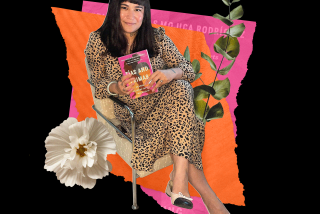Sonia Sotomayor explores her roots in ‘My Beloved World’
- Share via
My Beloved World
Sonia Sotomayor
Knopf: 336 pp., $27.95
Some of the most revealing moments in Sonia Sotomayor’s stirring new memoir, “My Beloved World,” come early in the book’s 300-plus pages.
The future Supreme Court justice is a mere 9 years old when her father dies in her family’s apartment in a Bronx housing project. He was a broken-hearted man with an artist’s soul and a weakness for Seagram’s Seven that eventually killed him.
Juan Sotomayor’s family is devastated by his early death. At his wake, after a night of endlessly repeated rosaries, Sonia nods off before the coffin. When she opens her eyes her relatives are arguing around her. Apparently, while she was asleep, Sonia had spoken a single Spanish word in the voice of a long departed aunt. Confórmate, she said. Accept it.
“I can’t explain it,” Sotomayor writes. “Nothing like that had happened to me before, and it hasn’t happened to me since.”
At age 9, and for much of her life, level-headed Sonia tells herself that reason can triumph over chaos and adversity. All around her adults act irrationally, slaves to their superstitions and passions. When her aunt later tries to climb into the grave with Sonia’s dead father, Sonia doesn’t understand: The aunt never came to visit when her father was alive.
“My Beloved World” is a record of the most difficult and improbable part of Sotomayor’s long journey from the Bronx projects to a seat on the Supreme Court. It begins with her birth to two young, unsettled parents with roots in impoverished, rural Puerto Rico. And it ends 38 years later with the realization of a dream she’s held since childhood: her first appointment as a judge.
While other recent memoirs by current and former justices have touched on weighty political and philosophical themes, Sotomayor avoids such terrain. A coming-of-age story, “My Beloved World” does not touch on a single day of her life as a Supreme Court justice. Instead, in her own often straightforward, occasionally soaring writing style, Sotomayor succeeds in “My Beloved World” in crafting an often old-fashioned tale of overcoming obstacles.
It’s a book explicitly intended to address her newfound role as a Latina role model. From her story of family and community strength and dysfunction, a worthy Latino addition to the pantheon of mythic American civic stories emerges.
Lincoln was a log-splitter, Washington chopped down the cherry tree — and Sotomayor was a smart girl from the projects who decided in grade school that she wanted to be a judge. In “My Beloved World” we learn that Sonia, having listened to her mother and father fight almost every day of their marriage, likes the idea of sorting out conflict. Her hero is the level-headed judge on the old “Perry Mason” television show.
Her Puerto Rican-born paternal grandmother is a rare calm and steady presence for Sonia during her earliest years. Abuelita is a supplier of “unconditional love, respect and confidence.” She can also out-haggle any street vendor, cook a mean sofrito, and channel the dead at séances. But abuelita is only a shadow of herself after the death of her son, Juan Luis. So is Sonia’s mother.
Like so many American immigrant and migrant narratives, it’s a story that returns to “a little wooden shack of a house” in the middle of crops and fields. Sonia’s mother lived in such a shack, in Lajas, Puerto Rico, eventually arriving in New York after enlisting in the Women’s Army Corps during World War II. In New York she met a young man named Juan Luis Sotomayor who recited poetry to her, in Spanish.
Narratives that link U.S. cities like New York to Latin America towns like Lajas are, increasingly, a defining element of the American experience — though they are still underrepresented in American letters. Sotomayor’s story connects the Latino immigrant experience to hallowed American institutions of learning and jurisprudence: What she’ll do with her own chunk of judicial power now that she has it, or what she thinks the law can do to improve the lives of people like her, are topics she’s apparently left for another book.
In “My Beloved World” we watch Sotomayor reach for her goals with a drive that’s already focused and fierce at an uncommonly young age. “This girl’s ambitions, odd as they may seem, are to become an attorney and someday marry,” a nun at Blessed Sacrament school writes in the school yearbook when Sonia graduates from the eighth grade.
In other words, it was “odd” for a Latina in the 1960s to dream of becoming a lawyer.
As a teenager at Cardinal Spellman High School, she reads “Lord of the Flies” and is haunted by its message: the desire to do good, and treat others with kindness can be undermined by selfishness and fear. Something similar, she can see, is happening in her corner of New York City, with gangs, junkies and even corrupt cops eating away at the city’s social fabric.
In “Lord of the Flies” the boys use a conch shell as a call to an assembly where rules are made, disputes settled. “The conch … stands for order, but it holds no power in itself,” Sotomayor writes. “Its only power is what they agree to honor. It is a beautiful thing, but fragile.”
Sotomayor’s account of her gradual, determined ascent through the American educational system is filled with incidents that will sound familiar to many Latino college graduates. When she gets a perfect score on a high school math test, she’s accused of cheating. At Princeton, she endures the diatribes against affirmative action provoked by the presence of a small number of students “of color” on campus. Snarky comments about women and Latinas follow her to Yale Law School too.
Sotomayor never lets these slights go unanswered, fighting back like the tough law-geek with a chip on her shoulder that she is. “You know what I love about you, Sonia?” a fellow student at Yale says. “You argue just like a guy.” Later, as a young assistant district attorney in New York, she develops a reputation for ruthlessness. Nothing can stop her — not even Type 1 diabetes — though her ambition and work ethic eventually undermine her marriage to her high school sweetheart.
In the end, Sotomayor achieves her goal, though it comes at a cost of an enduring loneliness that perhaps unwittingly colors the book’s final chapters. “My Beloved World” is the record of that solitary journey, and it ends with Sotomayor donning one set of black robes, soon to be followed by others. It’s an individual achievement that stands as a landmark in the much larger, collective civic awakening of the Latino U.S.
More to Read
Sign up for our Book Club newsletter
Get the latest news, events and more from the Los Angeles Times Book Club, and help us get L.A. reading and talking.
You may occasionally receive promotional content from the Los Angeles Times.










